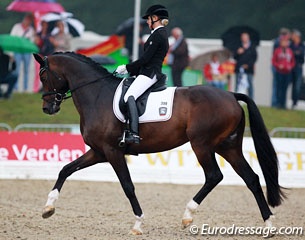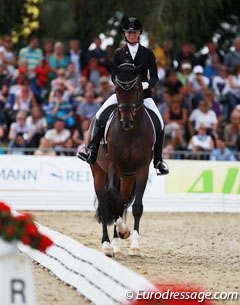
One of the most difficult parts of dressage is getting your horse straight and while many people may think they are straight, often when you take them away from the wall, which helps as a straightener, you see them wobble up the arena looking like a rabbit in the head lights. When you can make a three quarter line without your horse falling in, or out, or putting his quarters in or out, and without losing your line, the next step is being able to alter the degree of bend in your horse's neck without losing your line.
Often we see people who only use bend when they require it in a certain movement or exercise and so rarely bend the horse on a straight line. This usually results in a horse that the minute the rider goes to ask the bend, the horse thinks “Oh shoulder-in”, and so moves his shoulders to the same way as the bending, or “oh half-pass”, so falls to the inside and starts to move diagonally across.
Riders often forget that the key to effective bending lies in not only being able to bend the horse with the use of the torso and with an even contact on both reins, i.e. without pulling his head around, but also being able to bend the horse without losing the straightness of the line. To test this, once you have established the straight three quarter line, try coming down the three quarter line and first bending your horse left for 8 strides, and then bending the horse right for 8 strides.
What happened? Did you start zig zigging helplessly up the arena? Did you find it more difficult to bend to the left than to the right? Was this because you drew your left leg up and pulled on the left rein? Or did you not allow enough with the right rein? Or did you throw the right rein away so your horse fell off to the left?
Until you can control the bend, without pulling on the reins and without losing the straightness of your line, you cannot expect your horse to maintain the cadence in the more difficult lateral exercises. When you think you have control of the bend to both sides on the straight, you must use this as a test to see if your horse is on your aids.
As you come into the corner, put your horse into a little shoulder-in and then as you come onto the straight long side, ask your horse first to bend and then when you are ready ask for the shoulders to come in. Does your horse immediately try to begin the shoulder-in when you ask for the bend?
 Then half pass, come around the corner with a little shoulder-in and then attempt to first establish the bend and the angle of the half pass before you ask the horse to leave the wall. Did the horse leave the wall on you terms or his?
Then half pass, come around the corner with a little shoulder-in and then attempt to first establish the bend and the angle of the half pass before you ask the horse to leave the wall. Did the horse leave the wall on you terms or his?
In the canter bending is equally as difficult to achieve and particularly useful in the counter canter, where the movement demands more strength and more balance from both horse and rider. In counter canter, on the three quarter line, can you bend the horse to the left, and to the right, smoothy, calmly, without losing the jump in the canter, or the softness of the poll, and again without coming off your straight line?
Too many riders think of bending and then haul their horse's head off to one side, lose the impulsion, screw themselves up, and fall off their line and into the wall or into the inside of the arena. Wrong! Bending is not only about establishing elasticity and balance, but also about monitoring your elastic connection with the horses mouth, and also monitoring the degree of control you have over your horse's body.
A rider who relies on the reins to steer their horse, will not be able to bend the horse without losing the line, nor will they be able to bend the horse without one rein going slack. A rider who uses their seat and leg to engage the horse from back to front, will be able to make these alterations to the front part of the horse without losing their line, their impulsion, or their elastic contact on both reins.
You cannot effectively control the front of your horse, unless you have control over his behind!
by Sarah Warne for Eurodressage - Photos © Astrid Appels
Related Link
Sarah Warne's Classical Training Articles